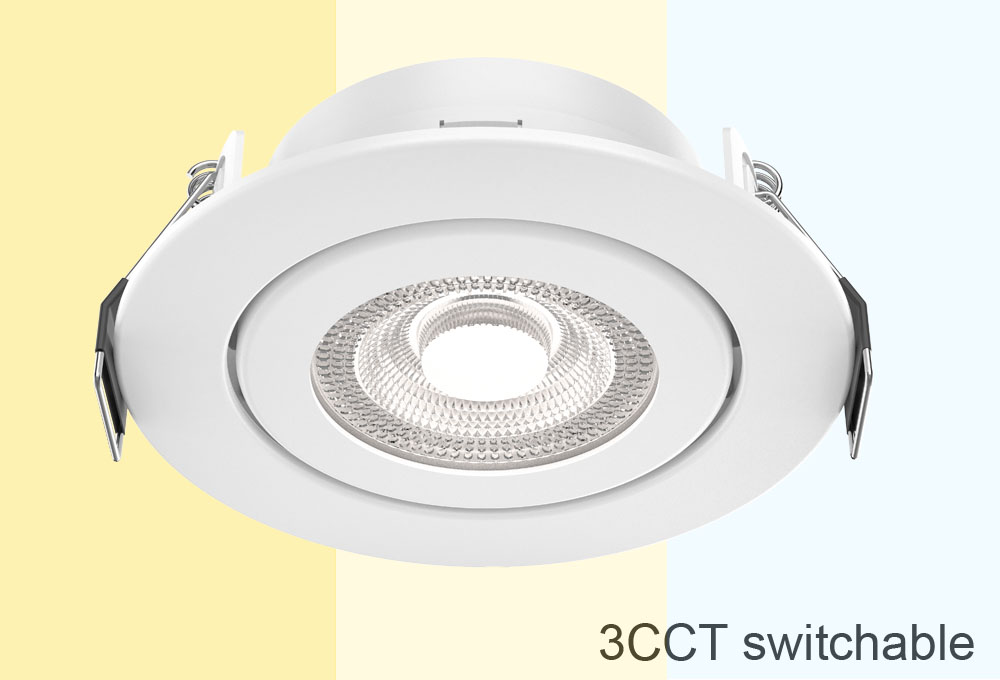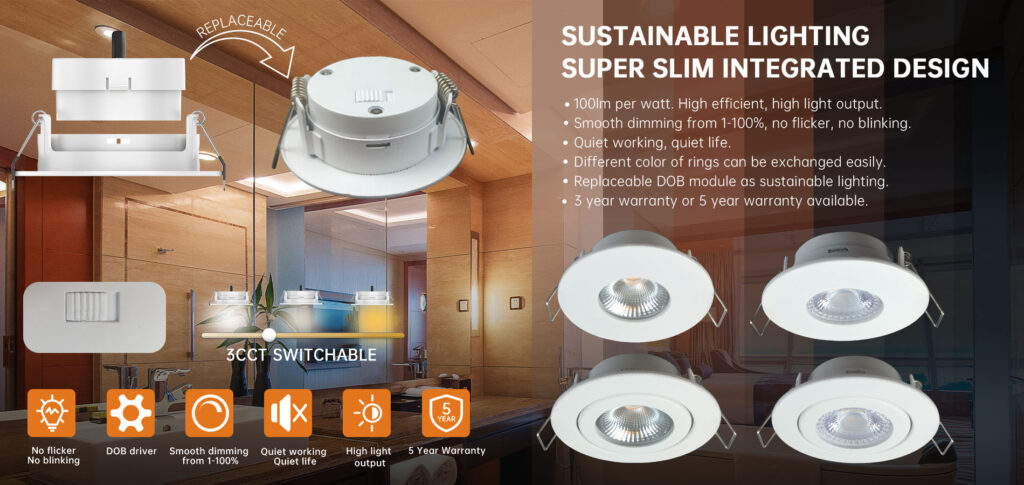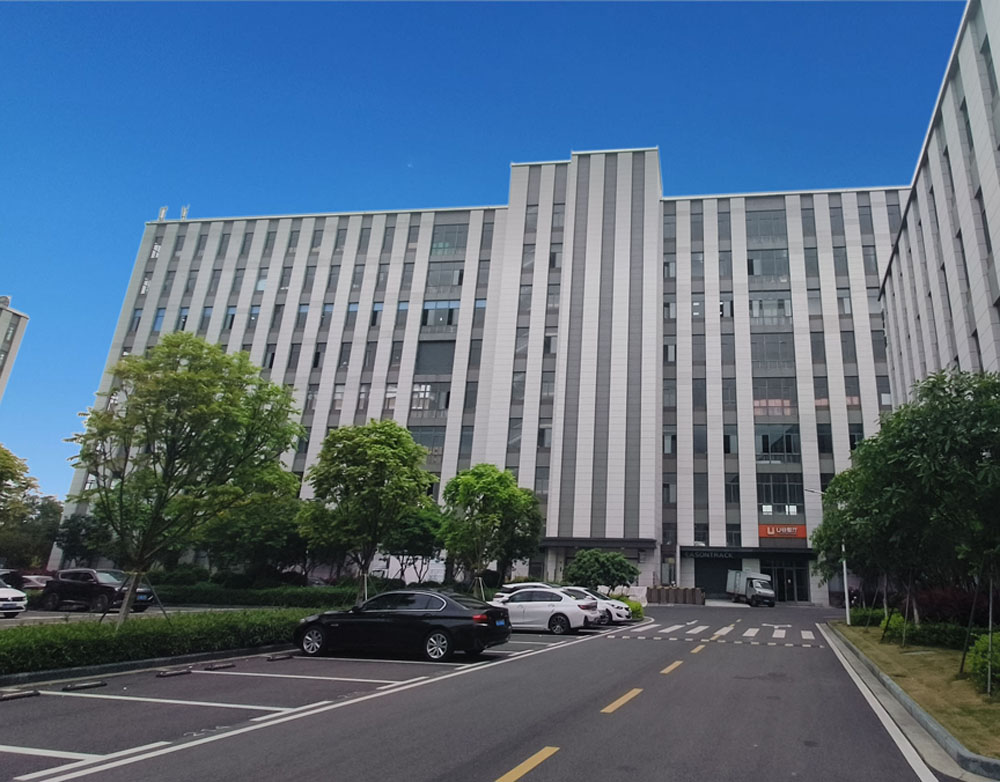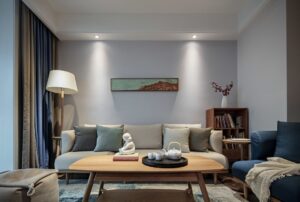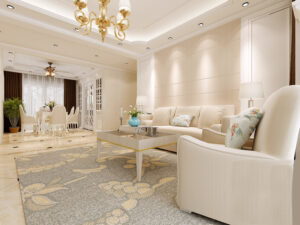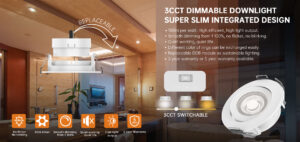At vælge det rigtige lys farvetemperatur (CCT) til dine værelser kan have en betydelig indflydelse på stemningen, funktionaliteten og den overordnede oplevelse af et rum. Denne vejledning hjælper dig med at forstå CCT, dens fordele, og hvordan du vælger den passende temperatur til forskellige miljøer.
Hvad er lysfarvetemperatur (CCT)?
Farvetemperatur, ofte omtalt som Correlated Color Temperature (CCT), beskriver den opfattede farve af lys, der udsendes fra en lyskilde som f.eks. downlight, spotlight, spor lys osv. Denne måling bruger Kelvin (K) skalaen til at sammenligne lysets farve med farven på en teoretisk "black body" radiator, der er opvarmet til den temperatur. En lavere CCT-værdi (generelt under 3200K) betyder et "varmere" lys udseende, karakteriseret ved gule og røde toner. Omvendt indikerer en højere CCT (over 4000K) et "kølere" lys, der hælder mod blå nuancer.
CCT er et spektrum fra omkring 2000K til 6500K. Her er hvordan forskellige CCT-intervaller påvirker følelsen af et rum:
- Varm hvid (2000K – 3000K): Skaber en afslappende og indbydende atmosfære, ligesom det bløde skær fra levende lys eller en solopgang.
- Neutral hvid eller dagslys (3500K – 4100K): Giver et afbalanceret og naturligt udseende lys, der ligner dagslys.
- Cool White (5000K – 6500K): Giver et klart og energigivende lys, der kan sammenlignes med middagssolen.
For eksempel falder det velkendte lys fra glødepærer normalt omkring 2700K, mens dagslys LED'er kan have CCT-værdier så høje som 6500K.
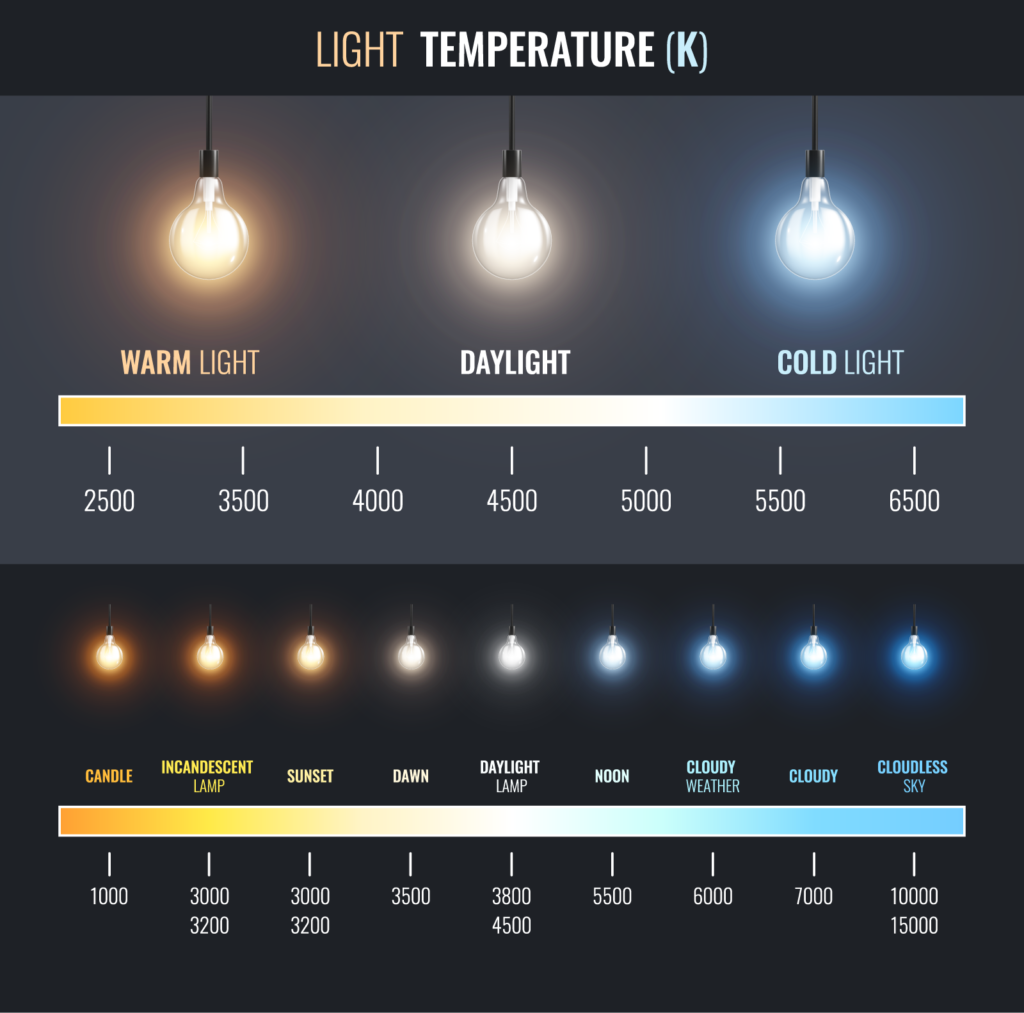
Hvordan virker lysfarvetemperatur (CCT)?
Begrebet farvetemperatur er dybt forankret i lysemissionens fysik. Det er baseret på princippet om, at når et teoretisk objekt, kendt som en sort kropsradiator, opvarmes til stadigt højere temperaturer, begynder det at udsende lys. Til at begynde med fremstår dette lys som en varm, rødlig nuance. Men efterhånden som temperaturen fortsætter med at stige, skifter det udsendte lys gradvist gennem et spektrum af farver og når til sidst et punkt, hvor det ser hvidt ud, og går derefter videre mod køligere, blåere toner.
For at illustrere dette fænomen kan du overveje et par velkendte eksempler: Flammen af et stearinlys, der brænder ved en relativt lav temperatur på cirka 1500 Kelvin (K), udsender en karakteristisk varm orange glød, hvilket skaber en hyggelig og intim stemning. I modsætning hertil producerer middagssollys, som registrerer omkring 5500K, et meget klarere og mere neutralt hvidt lys, ideelt til at oplyse rum med klarhed og liv. Desuden kan farvetemperaturen på himlen på en overskyet dag stige til 6500K eller endnu højere, hvilket resulterer i det kølige, blåfarvede lys, der ofte er forbundet med overskyede forhold.
Dette princip er utrolig vigtigt inden for lysdesign, da det giver en ramme for at forstå, hvordan kunstig belysning kan manipuleres til at efterligne kvaliteterne af naturligt lys på forskellige tidspunkter af dagen. Ved at måle farven på lys, der udsendes af en bestemt kilde, og sammenligne den med farven, der udsendes af en sort kropsradiator ved en bestemt temperatur, kan vi tildele en korreleret farvetemperatur (CCT) værdi til den lyskilde. Når temperaturen stiger, går lyset fra den varmere ende af spektret (røde og orange) til den køligere ende (blå). Dette forhold giver brugerne mulighed for at træffe informerede beslutninger, når de skal vælge belysningsløsninger, der stemmer overens med deres specifikke behov og præferencer.
For eksempel lavere CCT-værdier fra en lysressource som downlight eller spotlight, typisk under 3000K, fremkalder en følelse af varme, afslapning og intimitet. Disse lyskilder foretrækkes ofte i boligmiljøer som soveværelser og stuer, hvor målet er at skabe en behagelig og indbydende atmosfære. Omvendt fremmer højere CCT-værdier, generelt over 4000K, årvågenhed, koncentration og produktivitet. Dette gør dem velegnede til opgaveorienterede miljøer som kontorer, studier og køkkener, hvor klar og fokuseret belysning er afgørende. I sidste ende giver et solidt greb om farvetemperatur og dens implikationer individer mulighed for at sammensætte belysningsskemaer, der ikke kun forbedrer funktionaliteten af deres rum, men også bidrager til deres generelle velvære og æstetiske nydelse.
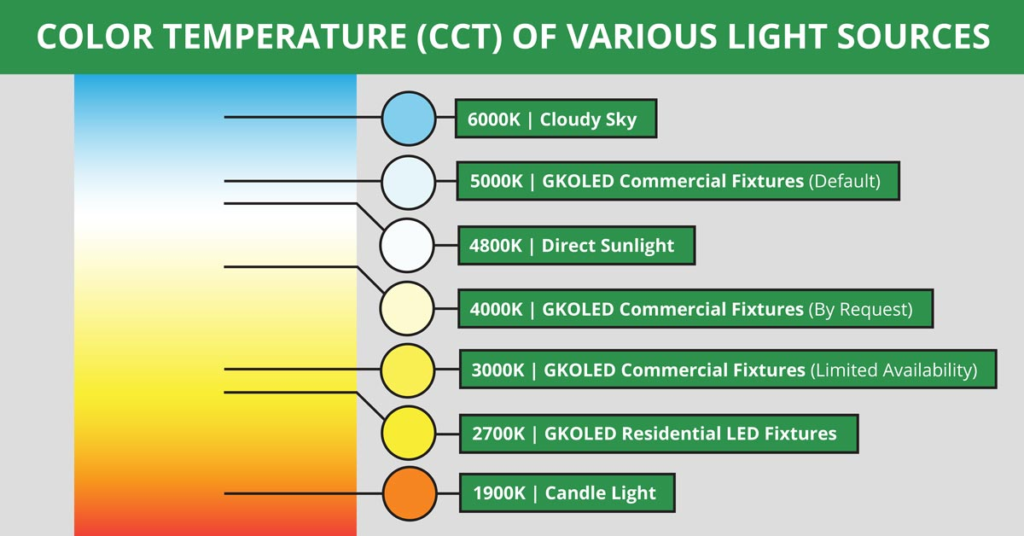
Den rigtige farvetemperatur god for menneskelig adfærd
Valg af den passende korrelerede farvetemperatur (CCT) til belysning kan give betydelige fordele på tværs af forskellige miljøer. Indflydelsen af CCT strækker sig til stemningsregulering, produktivitetsforbedring og et rums overordnede æstetiske tiltrækningskraft.
For eksempel i boligmiljøer fremmer varm belysning med lavere CCT-værdier afslapning og komfort, hvilket gør den ideel til stuer og soveværelser.
Omvendt er køligere lystemperaturer kendt for at øge årvågenhed og fokus, hvilket er særligt fordelagtigt i arbejdsmiljøer, hvor koncentration er nøglen. Forskning viser, at køligere lysindstillinger kan mindske træthed og forbedre den samlede produktivitet i kontormiljøer.
Ydermere spiller CCT en afgørende rolle i at fremhæve designelementer i både boliger og virksomheder. Ved omhyggeligt at vælge farvetemperaturer kan man skabe specifikke atmosfærer, hvad enten det er en indbydende og hyggelig stemning eller en professionel og energigivende ramme
De bedste fremgangsmåder til at vælge CCT i forskellige rum
At vælge den passende korrelerede farvetemperatur (CCT) er afgørende for at optimere funktionaliteten og stemningen i hvert værelse i dit hjem. CCT, målt i Kelvin, påvirker, hvor varmt (gult) eller køligt (blåt) lyset fremstår. Ved at forstå de specifikke behov og aktiviteter inden for hvert rum kan du skræddersy din belysning for at forbedre komfort, produktivitet og overordnet velvære.
Stue
Anbefalet CCT: 2700K – 3000K
Formål: Som et knudepunkt for afslapning og socialt samvær nyder stuen godt af varmere lystemperaturer, som fremmer en hyggelig og indbydende atmosfære ideel til familiesammenkomster eller rolige aftener.
Tips: Brug lamper udstyret med lysdæmpere, så du kan justere dæmpbar downlight intensitet baseret på tidspunktet på dagen eller aktiviteten, hvilket giver fleksibilitet og kontrol.
Inkorporer accentbelysning for at fremhæve kunstværker eller arkitektoniske træk, tilføje dybde og visuel interesse, mens du bevarer en varm, omgivende glød i hele rummet.
Soveværelse
Anbefalet CCT: 2700K – 3000K
Formål: Soveværelset skal tjene som et fristed for afslapning og afslappende søvn. Varmere lyse toner efterligner solnedgangens blide lys og signalerer, at kroppen skal slappe af og forberede sig til søvn.
Tips: Installer sengekanten væglampe eller bordlampe med blødt, varmt lys til læsning, der giver tilstrækkelig belysning uden overvældende lysstyrke, der kan forstyrre det beroligende miljø.
Undgå hårdt hvidt lys, da det kan forstyrre kroppens naturlige søvn-vågen-cyklus og hindre afslapning.
Køkken
Anbefalet CCT: 3000K – 4000K
Formål: Køkkener kræver skarp, klar belysning til opgaver som madlavning og madlavning. Et neutralt hvidt lys fra køkken under skab downlight er fejlsikker. Kølere temperaturer forbedrer synlighed og fokus, hvilket sikrer sikkerhed og effektivitet i køkkenet.
Tips: Implementere belysning under kabinettet til at oplyse arbejdsflader direkte, eliminere skygger og forbedre synlighed under tilberedning af måltider.
Inkorporer justerbare belysningsmuligheder, så du kan skifte mellem varmere toner under spisning og køligere toner, mens du laver mad, der tilgodeser forskellige behov og præferencer.
Badeværelse
Anbefalet CCT: 3000K – 4000K
Formål: Badeværelser kræver en balance mellem varme og klarhed til plejeopgaver. Et neutralt til køligt hvidt lys giver tilstrækkelig belysning uden at være for hårdt, hvilket sikrer nøjagtig farvegengivelse og synlighed.
Tips: Brug sminkelamper omkring spejle, der giver jævn belysning, minimerer skygger og sikrer nøjagtig refleksion til pleje og makeup.
Overvej frostede armaturer for at sprede lyset blødt, reducere blænding og skabe et mere behageligt og flatterende lysmiljø, samtidig med at tilstrækkelig lysstyrke bevares. Bortset fra CCT, bør vi tage vandtæt vurdering i betragtning. vi burde vælge vandtæt downlight, spotlights eller andet lys med IP44 i hvert fald eller IP65 til badeværelse
Hjemmekontor
Anbefalet CCT: 4000K – 6500K
Formål: Et hjemmekontor skal fremme koncentration og produktivitet. Efterligner naturligt dagslys, køligere temperaturer hjælper med at reducere øjenbelastning og træthed under lange arbejdstimer.
Tips: Brug opgavebelysning med justerbare farvetemperaturer, så de passer til forskellige tidspunkter på dagen eller specifikke opgaver, så du kan tilpasse belysningen for at optimere fokus og komfort. Desuden, hvis vi skal bruge meget tid på vores hjemmekontor for at arbejde eller studere. Vi bør vælge nogle lys med mindre blåt lys og lavt UGR(blæse UGR 16) at beskytte vores øjne.
Kombiner overheadbelysning med skrivebordslamper for optimal belysning, sikring af tilstrækkelig lysdækning og minimering af skygger i arbejdsområdet.
Spisestue
Anbefalet CCT: 2700K – 3500K
Formål: Spisestuen skal skabe en imødekommende atmosfære, der forstærker madoplevelsen. Varme til neutrale toner kan stimulere appetit og samtale og fremme en følelse af hygge.
Tips: Brug pendellamper eller lysekroner med lysdæmpere til at justere stemningen under måltiderne, hvilket skaber en mere intim og indbydende stemning.
Inkorporer levende lys eller bløde bordlamper for en intime ramme, der tilføjer varme og charme til madoplevelsen.
Gange og indgange
Anbefalet CCT: 2700K – 3500K
Formål: Disse områder skal føles indbydende og alligevel funktionelle. Varmere toner kan skabe en venlig atmosfære og samtidig sikre synlighed for sikkerhed.
Tips: Ansæt væglamper eller indbygget belysning at give tilstrækkelig belysning uden overvældende lysstyrke, hvilket sikrer sikker passage og en indbydende atmosfære.
Overvej bevægelsessensorlys for nemheds skyld, der giver håndfri belysning og forbedrer energieffektiviteten i disse overgangsrum.B

Yderligere overvejelser
Dæmpbar belysning: Udnytter dæmpbare lys giver mulighed for justerbar lysintensitet, så du kan ændre stemningen, så den passer til forskellige aktiviteter og tidspunkter på dagen.
Color Rendering Index (CRI): Sigt efter lyskilder med en CRI på 80 eller højere for at sikre nøjagtig farvegengivelse, hvilket er særligt vigtigt i områder som køkkener og badeværelser.
Personlig præference: Selvom disse retningslinjer giver et udgangspunkt, bør personlig komfort og æstetiske præferencer i sidste ende styre dine valg af belysning.
Bekvemmeligheden ved CCT Swicthable-produkter
At vælge den rigtige lampe kan være udfordrende, hvilket ofte fører til senere udskiftninger. Radians lampen med justerbar farvetemperatur løser dette problem perfekt. Undgå bekymringen om at vælge den forkerte lampe. Radians leverer en alsidig belysningsløsning, der tilpasser sig dine behov, så du sparer tid og penge.
Radians' CCT justerbare downlights tilbyder flere nøglefunktioner:
- 3CCT omskiftelig: 2700K-3200K-4000K eller 3000K-4000K-5700K
- Højt lumenoutput: Op til 100 lumen pr. watt.
- Glat dæmpning: 0-100% triac dæmpning, jævn dæmpning, flimmerfri.
- Silent Performance: Fungerer uden støj.
- Bæredygtigt design: Udskifteligt, førerløst (integreret indbygget driver) modul.
- Lang levetid: understøttet af en 5-års garanti.
Fordele for forhandlere og kunder
For forhandlere reducerer det justerbare CCT-design lagerbehovet ved at eliminere nødvendigheden af at have hver farvetemperatur på lager. Kunder drager fordel af forenklede designbeslutninger; Skift nemt farvetemperaturen selv efter installationen, hvis det er nødvendigt.
Yderligere belysningsløsninger
Udover justerbare farvetemperaturdæmpende downlights tilbyder Radians vandtætte downlights, antirefleks downlights, justerbare farvetemperatur panellys, baggrundsbelyste panellys, og justerbare farvetemperatur spor lys.
Radians, etableret i 2019, har specialiseret sig i design, produktion, salg og markedsføring af downlights, spor lys, panellys og etc. Radians repræsenterer unikt design, kvalitet og professionel service, der tilfører dygtighed og passion i ethvert belysningsprodukt. De fleste produkter er CE- og RoHS-certificerede. Målet er at udvikle og fremstille smukke, effektive lamper.
Konklusion
Valg af passende lys farvetemperatur (CCT) for hvert værelse forbedrer et hjems funktionalitet og æstetik. At forstå hvert rums formål, og hvordan forskellige lystemperaturer påvirker humør og aktivitet, giver dig mulighed for at skabe et behageligt og indbydende miljø, der understøtter din livsstil.
Ofte stillede spørgsmål
Q: Kan jeg blande forskellige CCT'er i ét rum?
A: Ja! Lag varm omgivende belysning med kølige arbejdslamper for balance.
Q: Hvilken CCT er bedst til øjensundhed?
A: 2700K–3000K om natten reducerer eksponeringen for blåt lys, hvilket hjælper søvnen.
Spørgsmål: Påvirker CCT energieffektiviteten?
A: Nej – effektivitet afhænger af pæretype (LED vs. glødelampe), ikke Kelvin.

